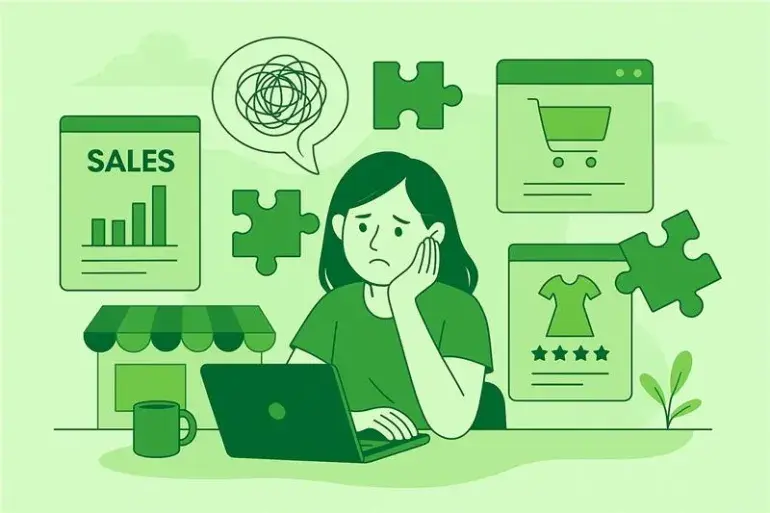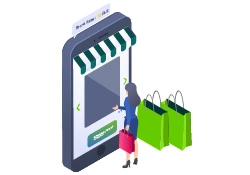Software Fatigue in Retail? Here’s How Unified Retail Software Solves the Puzzle

At 9:00 a.m., a store manager logs into the point-of-sale system. Around 9:10 a.m. she's juggling inventory through a separate tool. 10 minutes later, customer data is pulled from a third platform. Orders are synced through a fourth. By lunchtime, she’s toggled through at least six systems all designed to make retail "easier." Sound familiar?
Welcome to the world of modern retail, where complexity masquerades as capability. The average mid-size retailer today uses multiple software tools to run daily operations from POS to e-commerce platforms, ERP systems, CRMs, inventory management tools, marketing automation suites, and more. Each promises efficiency, but together, they deliver chaos.
The cracks show fast, duplicate logins and conflicting data. Employees are bogged down by platform switching. Insights are delayed because systems don’t talk to each other. And consumers experience out-of-stock errors, inconsistent service, and delayed updates.
This is Software Fatigue - the silent drain of working across fragmented retail systems. In the race to meet customer expectations, software fatigue becomes tangible, exhausting, and costly. Retailers don’t need more tools. They need one intelligent solution. Let's see how a single unified retail software dissolves fragmentation, aligns systems, and turns operational fatigue into strategic clarity.

Turn retail fatigue into seamless retail systems with Ginesys today
What Is Software Fatigue?
Software Fatigue is the operational strain and inefficiency caused by juggling too many disconnected digital tools, often starting innocently in retail with small additions like a new CRM or POS upgrade. As they expand, your tech stack becomes a mess of disconnected systems that are siloed due to human error, manual reconciliation, distinct training, and ongoing maintenance. And here’s the kicker: many retailers don’t even realize they’re bleeding time and money until it’s too late.
Where exactly does it hurt? Let's explore:
- Decision fatigue: When a store manager must click through five dashboards to make a pricing decision, it’s not strategy - it’s survival.
- Burnout risk: According to a Microsoft Work Trend Index 2024 study, 68% of frontline retail workers said too many apps hinder productivity.
- Customer experience failures: If the online store says “it’s in stock” but the POS doesn’t, the customer’s confidence is lost and likely doesn’t return.
- Operational drag: According to research conducted by Forrester, multi-platform environments cause unnecessary data entry duplication of up to 35%.
- Training overhead: Every new tool comes with its learning curve. When employees spend more time learning systems than serving customers, everyone loses.
- Financial bleed: A SaaS Management Survey showed, the average mid-size company pays for 254 software apps, but only actively uses 45% of them.
Why Retail Is Especially Vulnerable
Post-COVID, retail entered a new era: survival through digital acceleration. In 2020 alone, U.S. e-commerce penetration jumped from 16% to 27% in eight weeks - a decade’s worth of growth in just two months. And with that came a scramble to digitize, often piecemeal.
Today’s retail is about creating a synchronized experience across:
- Point-of-sale terminals
- Online storefronts
- Mobile shopping apps
- Social commerce platforms
- Customer support systems
And each of these layers must be continuously synchronized. A delay in order fulfillment on Shopify ripples through returns, loyalty programs, and customer support channels. The pressure is immense:
- Omnichannel complexity: 74% of customers expect a consistent experience across channels.
- Analytics expectations: Real-time data is important, and retailers need to react to buying patterns as they happen, not days later.
- Automation dependencies: From predictive restocking to personalized offers, automation only works if systems are unified.

Signs You’re Suffering from Software Fatigue
In 2025, retailers are drowning in tools. From standalone inventory trackers to fragmented POS apps, Software fatigue is no longer a possibility. But how do you know it’s taken hold?
- Lag between sales and inventory updates: If a customer buys the last pair of size 9 sneakers online, but your store still shows them in stock an hour later, you’re already behind. According to McKinsey, real-time inventory visibility is now expected by 82% of omnichannel consumers.
- Duplicate data entries or reconciliation efforts: Are your teams manually syncing data across systems after hours? Manual entry can result in data error rates of up to 3.7%, according to IBM's Data Quality study.
- Customer complaints due to stockouts or delays: You promised a two-day delivery. The product was "available" at checkout. Now it’s been backordered for three weeks. Nearly 70% of customers will switch brands after just one such bad experience, as per PwC’s Global Consumer Insights.
- Confused store staff switching between apps/systems: Your frontline team did not choose a career in IT. Yet they’re juggling between five different apps to handle a return.
- No visibility for decision makers in real-time: If the decisions you make in your company are based on yesterday’s data, you’re not leading – you’re reacting. According to Gartner, 72% of retail leadership agreed that the lack of aggregated data remains a barrier to agility.
The True Cost of Software Fatigue
The symptoms are visible. But the costs? Often buried. Now, let’s shed some light on what fragmentation is costing your retail business:
- Loss of agility and innovation: A broken tech stack takes forever to roll out, bottlenecks promotions, and clogs launches. Deloitte discovered that companies that utilize integrated services are 30% quicker to market new offerings than siloed systems.
- Hidden operating costs due to manual interventions: Piecing together broken integrations with people instead of code incurs accumulating hidden costs. This while a significant portion of IT budgets is being spent on aligning disparate software systems, especially for enterprise and large-format retailers.
- Customer churn increases due to inconsistent experience: A fractured experience comes at a cost. According to Salesforce, 76% of customers expect consistent treatment across all departments.

One Suite. Zero Stress. Discover Ginesys One Today
Unified Retail Software: The Antidote to Fatigue
Integrated retail technology is the digital system that combines all retail core functions - point of sale, inventory, purchasing, customer loyalty, e-commerce, warehousing into a single, real-time ecosystem. One platform, one data source, and one version of the truth.
- Breaks down silos and unifies workflows: This means no more batons passed between departments or duplicated processes. Marketing knows what is in stock. Finance sees live sales. Managers at stores can order, price, and restock with a single click.
- Real-time data sync between store, warehouse, online, and back-office: Whether a product sells in-store, online, or via marketplace, inventory levels update instantly across all channels.
- One source of truth: Every retail function - inventory, customer data, sales, and finance are built on a shared foundation.
- Orchestrates Retail Operations: Connects the entire retail operation - POS, inventory, procurement, loyalty, warehousing, and e-commerce.
Integration Challenges – The Hidden Hurdle
You can purchase the best-in-class tools for any retail function - POS, ERP, CRM, OMS and still have a system that collapses in on itself. Why? Integration.
The hard truth is that integration, not software quality, is often the bottleneck in retail tech stacks. 65% of the major retailers taking part in a 2023 Retail Systems Research reported that the greatest difficulty of their digital transformation journey was related to integrating new technologies with legacy systems.
Let’s unpack the hidden obstacles:
- Legacy systems that don’t talk to each other – Picture a 15-year-old inventory system trying to sync with a cloud-based CRM. The result? Workflows shattered, teams frustrated, workarounds costly.
- Time-consuming, expensive custom APIs – Development of custom APIs can take weeks or even months. These integration expenses can eat up a lot of your digital transformation budget in a hurry.
- Risk of data mismatch or loss during syncs – According to a Deloitte report from 2024, lack of data integrity is often the second biggest reason behind retail system failures, right after poor integration planning.
- Endless testing and re-testing – Even a small coding tweak can lead to sync errors. And when it does? The IT crew becomes a 24/7 firefighting gang.
- Vendor finger-pointing – As systems go live, finger-pointing begins. Is it the POS vendor? The CRM provider? The integration partner? Meanwhile, sales come to a halt.
So, what’s the answer?

End Software Fatigue – Run Retail Smarter with Ginesys One
Unified Retail Software Removes the Guesswork
Unified retail platforms eliminate the friction by doing the heavy lifting long before you ever interact with the system. According to IDC, retailers using unified commerce platforms report 35% lower IT overhead compared to those on stitched-together solutions. Let’s break it down:
- Pre-integrated modules – POS, ERP, OMS, and CRM are built to work seamlessly.
- Seamless data handoff – Sales, inventory, data about customers - everything gets updated automatically for the latest data across all applications.
- Fewer moving parts – Fewer parts mean fewer breakages. Simple architecture scales better and breaks less.
- Reduced maintenance – With fewer vendors and pre-built integrations, the IT burden drops dramatically.
The Psychology of Retail Simplicity
Technology conditions behavior, mindset, and decision-making, especially under high-pressure retail conditions. This ties into cognitive load theory, a psychological model with surprising applicability to operations. The theory says the more mental effort required to complete a task, the more likely it is to result in errors, stress, and delay. A messy tech stack is a cognitive minefield in a fast-paced world of retail where every second counts.
But with a unified retail system:
- Streamlined workflows cut through noise – Instead of toggling between dashboards, you have one command center.
- Real-time visibility reduces anxiety – You’re not wondering if the inventory data is an hour old. You know it’s current. You trust it. That confidence? It’s measurable.
- Intuitive tools boost morale – When systems make sense, people feel capable, leading to better performance.

Meet Ginesys One – The Retail OS
The retail space in India is omnichannel, hyper-competitive, and GST-laden. It spans B2B and D2C and is evolving at a pace that legacy systems can’t keep up with. The result? Software fatigue fragmentation, disconnected data, and angry teams.
Now, what if all of that were done by one system? Say Hello to Ginesys One, the Retail Operating System engineered for Indian retail realities. Ginesys One is not just a software solution; it’s the One operating system for 35,000 retail destinations in India. Loved by Manyavar, Soch, Mufti, and other leading brands, it’s custom-fitted for an ecosystem where both the cashier counter and the checkout cart are important, where compliance is not just necessary but mandatory, and where growth is both digital and physical.
So, what makes Ginesys One exceptional?
- Omnichannel-First Architecture: Crafted to eradicate the distinction between online and offline, it smoothens transitions from a customer walking into a store to them finishing the purchase online.
- Modular + Fully Integrated Suite: Businesses can scale without rebuilding systems. Pick what you need, when you need it.
- Lightning-Fast POS with Cloud Sync: Whether it’s a festival rush or the off-season lull, transactions are quick, synced, and reliable even on patchy internet.
- Powerful Warehouse and Inventory Tools: Real-time inventory visibility across stores, warehouses, and marketplaces. Overstock and stockouts have become things of the past.
- Embedded Analytics and Decision Tools: No more gut decisions. Get dashboards that tell you what’s happening and what to do next.
- E-commerce Sync: Direct integrations with Amazon, Flipkart, Myntra, and Shopify cut the manual work and sync orders, returns, and pricing in real time.
- Robust APIs and Integrations: From Shopify to payment gateways to accounting tools - Ginesys One connects well with others.
The product suite is as strategic as it is expansive:
- Ginesys Core: The foundation - POS, ERP, and inventory, tightly integrated.
- Zwing: A cloud-native POS that brings mobility and modern UX to the shop floor.
- Browntape: End-to-end marketplace and omnichannel management.
- Ginesys One: The umbrella suite that ties it all together.
5 Ways Ginesys’ Unified Software Transforms Retail
Here’s the real question: What does it feel like to run a retail business without friction?
Ginesys One answers that systematically, intelligently, and scalably.
- Smarter Inventory: How much revenue is lost every year because the right stock isn’t in the right place? Retailers globally lose $1.77 trillion due to inventory distortion, according to a report by IHL Group 2023. Ginesys flips this script. Centralized inventory visibility together with predictive replenishment means stock is where it needs to be - before customers make a purchase.
- Faster Decisions: Time has become the new currency in retail. Ginesys gives you real-time dashboards that not only show you the numbers but turn them into actionable insights. Not sure which SKUs are getting slow or where discounts are eating margin? It's all there. By replacing spreadsheets with live analytics, businesses can respond to trends as they happen.
- Unified Customer Experience (CX): A unified customer ID is used by Ginesys to map customer behavior, preferences, loyalty points, and offers across all channels. The result? One intelligent, unified experience that increases customer lifetime value.
- Simplified Compliance: India’s GST system is complex. Add e-invoicing, audit trails, and reconciliation, and it’s a maze. Ginesys One turns this into a background process. Every invoice, tax return, and compliance document is generated and tracked automatically.
- Scalability: Thinking of opening 10 stores next year? Adding Shopify and Amazon to your channel mix? Ginesys enables this growth. Because it’s modular, cloud-powered, and API-connected, scaling across locations and platforms becomes a matter of configuration.

Retail Growth Starts Here – Power Up with Ginesys.
Final Thoughts: Make the Shift Before You Burn Out
Each disconnected system makes another layer of the puzzle. Every manual workaround saps time. The longer gaps between the harmonies mean missed sales, inaccurate forecasting, and frustrated customers. The result? Burnout of your staff, your systems, and eventually, your competitive edge.
Now ask yourself: what if the pieces actually fit? That’s where unified retail platforms change the game. When systems communicate natively across POS, supply chain, ecommerce, promotions, and finance - clarity takes over. Decision-making speeds up. Real-time inventory becomes a reality. Loyalty data becomes actionable, rather than archival.
So do not let the cracks become chasms. Look for integrated retail platforms such as Ginesys, designed to give end-to-end visibility, seamless integration, and highly efficient scaling.
Make the shift today with Ginesys and future-proof your retail business!
